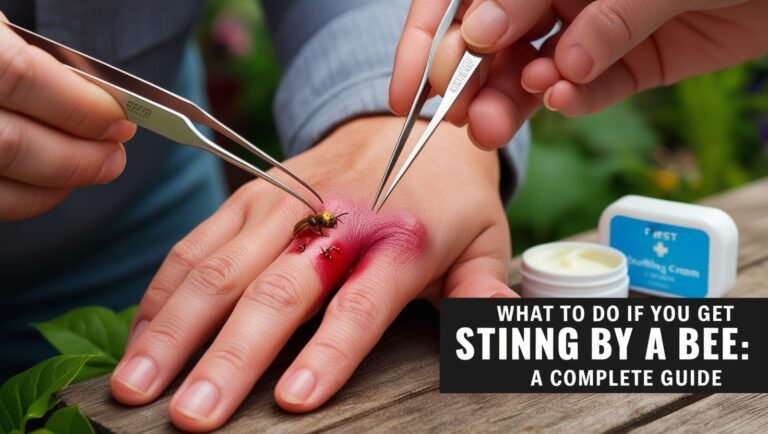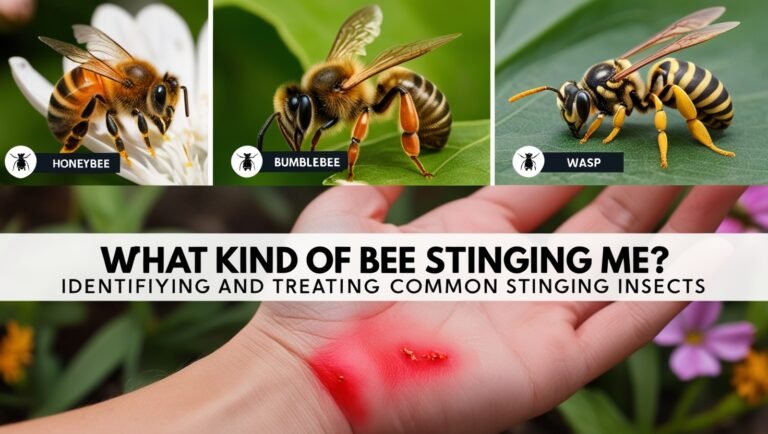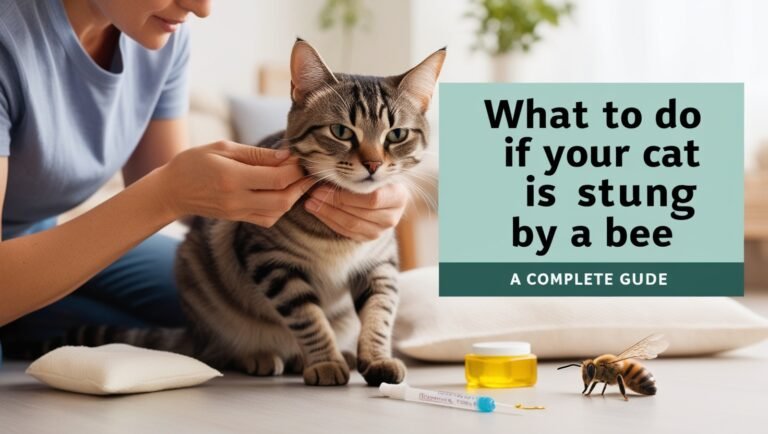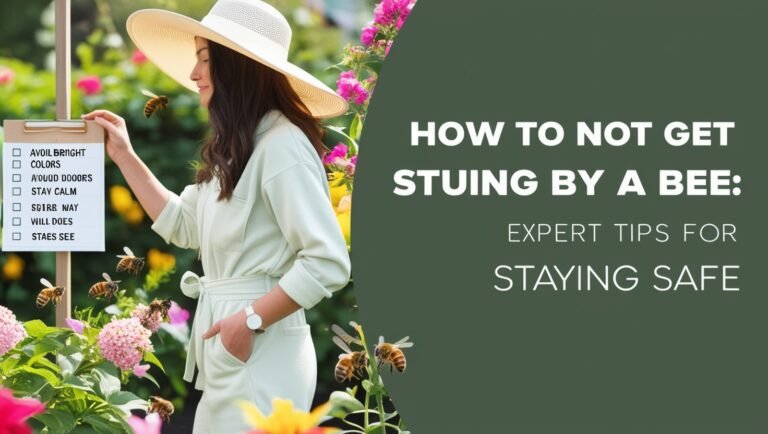When You Get Stung by a Bee: Essential Steps and Expert Advice

When you get stung by a bee, quick action and proper care are crucial. This comprehensive guide will walk you through everything you need to know about bee stings, from immediate treatment to long-term management. Whether you’re dealing with a minor sting or concerned about allergic reactions, we’ve got you covered with expert advice and practical tips.
Immediate Actions After a Bee Sting
The moments right after a bee sting are critical. Taking the right steps can minimize pain and prevent complications. Here’s what you should do:
Identifying the Sting
First, confirm that it’s indeed a bee sting. Bee stings typically cause a sharp, burning pain followed by a red, swollen bump with a white spot where the stinger entered the skin.
Removing the Stinger Safely
If stung by a honeybee, remove the stinger as quickly as possible. Here’s how:
- Scrape the stinger out with a straight-edged object like a credit card or fingernail.
- Don’t use tweezers, as they may squeeze the venom sac and release more venom.
- Act fast – most venom is released within the first few minutes.
Cleaning the Affected Area
After removing the stinger:
- Wash the area gently with soap and water.
- Apply an antiseptic to prevent infection.
- Keep the sting site clean and dry to promote healing.
Understanding Bee Sting Reactions
Not all bee sting reactions are the same. Knowing the difference can help you respond appropriately.
Mild Local Reactions
Most people experience mild reactions, which include:
- Sharp, burning pain at the sting site
- Redness and warmth around the area
- Slight swelling
- Itching
These symptoms usually subside within a few hours to a day.
Large Local Reactions
Some people may experience more significant swelling that can increase for 48 hours after the sting and may take up to 10 days to completely resolve. This is not necessarily a sign of allergy but can be uncomfortable.
Severe Allergic Reactions (Anaphylaxis)
A small percentage of people may have severe allergic reactions to bee stings. Symptoms of anaphylaxis include:
- Difficulty breathing
- Hives or swelling beyond the sting site
- Throat and tongue swelling
- Dizziness or fainting
- Nausea or vomiting
- Rapid pulse
Anaphylaxis is a medical emergency requiring immediate attention.
Treating Bee Sting Symptoms at Home
For mild to moderate reactions, several home remedies can provide relief.
Pain Relief Methods
To alleviate pain:
- Apply a cold compress to reduce pain and swelling.
- Take over-the-counter pain relievers like ibuprofen or acetaminophen.
- Use calamine lotion or hydrocortisone cream to soothe the skin.
Reducing Swelling and Itching
To combat swelling and itching:
- Elevate the affected limb if possible.
- Apply an antihistamine cream or take oral antihistamines.
- Use a baking soda paste (mix baking soda with a little water) on the sting site.
Natural Remedies for Bee Stings
Some people find relief with natural remedies:
- Apply honey to the sting site (ironically, bee product helps with bee stings).
- Use a crushed plantain leaf as a poultice.
- Try apple cider vinegar to neutralize the venom.
Remember, while these natural remedies may help, they’re not substitutes for medical treatment in case of severe reactions.
When to Seek Medical Attention for a Bee Sting
While most bee stings can be treated at home, some situations require professional medical care.
Signs of a Severe Allergic Reaction
Seek immediate medical help if you notice:
- Difficulty breathing or wheezing
- Swelling of the throat or tongue
- Dizziness or fainting
- Nausea or vomiting
- A rapid, weak pulse
- Loss of consciousness
These could be signs of anaphylaxis, a life-threatening condition.
Complications from Multiple Stings
Multiple stings can be dangerous, even for non-allergic individuals. Seek medical attention if:
- You’ve been stung more than 10 times
- You’re experiencing symptoms beyond the sting sites
- You have a headache, fever, or feel generally unwell after multiple stings
Stings in Sensitive Areas
Some sting locations are more concerning:
- Stings inside the mouth or throat can cause dangerous swelling
- Eye stings may affect vision
- Stings on or near the neck could compromise breathing
When stung in these areas, it’s best to consult a healthcare professional.
Bee Sting First Aid Kit Essentials
Being prepared can make a big difference when dealing with bee stings.
Must-Have Items for Treating Stings
A well-stocked first aid kit should include:
- Antihistamine tablets and cream
- Pain relievers (ibuprofen or acetaminophen)
- Hydrocortisone cream
- Calamine lotion
- Antiseptic wipes
- Tweezers (for removing stingers from wasps or hornets)
- Cold pack
- Bandages and gauze
Using an Epinephrine Auto-Injector
For those with known bee sting allergies:
- Always carry an epinephrine auto-injector (like an EpiPen).
- Make sure family and friends know how to use it.
- Check expiration dates regularly and replace as needed.
- Even after using the auto-injector, seek medical attention.
Preventing Future Bee Stings
The best way to deal with bee stings is to avoid them altogether.
Identifying Common Stinging Insects
Learn to recognize different stinging insects:
- Honeybees: Round, fuzzy bodies with distinct stripes
- Bumblebees: Larger, rounder, and fuzzier than honeybees
- Wasps: Slender bodies with narrow waists, often brightly colored
- Hornets: Larger than wasps, with chunkier bodies
Knowing which insects are in your area can help you avoid them.
Bee-Proofing Your Outdoor Activities
Take these precautions when outdoors:
- Avoid wearing bright colors or floral patterns
- Don’t use scented products like perfumes or hair sprays
- Keep food and drinks covered when eating outside
- Be cautious around flowering plants and garbage areas
- Stay calm if a bee approaches – don’t swat at it
Proper Attire to Avoid Stings
Dress appropriately when in bee-prone areas:
- Wear closed-toe shoes
- Opt for light-colored, smooth-finished clothing
- Avoid loose-fitting clothes where bees could get trapped
- Consider wearing a hat to protect your head and face
Myths and Facts About Bee Stings
Separating fact from fiction can help you respond better to bee stings.
Common Misconceptions Debunked
Let’s clear up some myths:
- Myth: All bees die after stinging. Fact: Only honeybees die after stinging; wasps and bumblebees can sting multiple times.
- Myth: Larger local reactions mean you’re allergic. Fact: Large local reactions don’t necessarily indicate an allergy.
- Myth: You can build immunity by getting stung repeatedly. Fact: Repeated stings can actually increase sensitivity in some people.
Scientific Truths About Bee Venom
Understanding bee venom can help you appreciate why proper treatment is crucial:
- Bee venom is a complex mixture of proteins and peptides.
- It causes pain and inflammation to deter predators.
- Some components of bee venom are being studied for potential medical applications.
Special Considerations for Children and Pets
Bee stings can be particularly distressing for kids and animals.
Helping Kids Deal with Bee Stings
When a child is stung:
- Stay calm to help the child remain calm.
- Remove the stinger quickly if present.
- Apply a cold compress to reduce pain and swelling.
- Use age-appropriate pain relievers if needed.
- Distract the child with activities or stories to take their mind off the sting.
What to Do If Your Pet Gets Stung
If your pet is stung:
- Look for signs of an allergic reaction (difficulty breathing, excessive swelling).
- Remove the stinger if you can see it.
- Apply a cold compress to the area.
- Contact your veterinarian, especially if your pet was stung multiple times or shows signs of distress.
Long-Term Management for Bee Sting Allergies
For those with bee sting allergies, long-term management is crucial.
Allergy Testing and Diagnosis
If you suspect a bee sting allergy:
- Consult an allergist for proper testing.
- Skin tests or blood tests can confirm the allergy.
- Your doctor may recommend an action plan based on your allergy severity.
Venom Immunotherapy Options
For severe allergies, venom immunotherapy may be recommended:
- This treatment involves receiving gradually increasing doses of bee venom.
- It can reduce the risk of severe reactions to future stings.
- The treatment typically lasts 3-5 years.
- Success rates are high, often providing long-term protection.
The Ecological Importance of Bees
While we focus on avoiding stings, it’s crucial to remember the vital role bees play in our ecosystem.
Balancing Safety and Conservation
Here’s how to stay safe while supporting bee populations:
- Avoid disturbing bee hives or nests.
- Plant bee-friendly flowers in your garden.
- Reduce or eliminate pesticide use in your yard.
- Support local beekeepers by buying local honey.
Supporting Bee Populations Responsibly
You can help bees without putting yourself at risk:
- Create bee-friendly habitats away from high-traffic areas.
- Leave patches of bare soil for ground-nesting bees.
- Provide shallow water sources for bees to drink from.
- Educate others about the importance of bees and how to coexist safely with them.
Let’s Complete
When you get stung by a bee, quick action and proper care are key to minimizing discomfort and preventing complications. By understanding the different types of reactions, knowing how to treat stings at home, and recognizing when to seek medical help, you can handle bee stings with confidence. Remember to take preventive measures to avoid future stings, and always be prepared with a well-stocked first aid kit. While we focus on protecting ourselves, it’s also important to appreciate the crucial role bees play in our environment and support their conservation efforts responsibly. Stay informed, stay prepared, and enjoy the outdoors safely!




